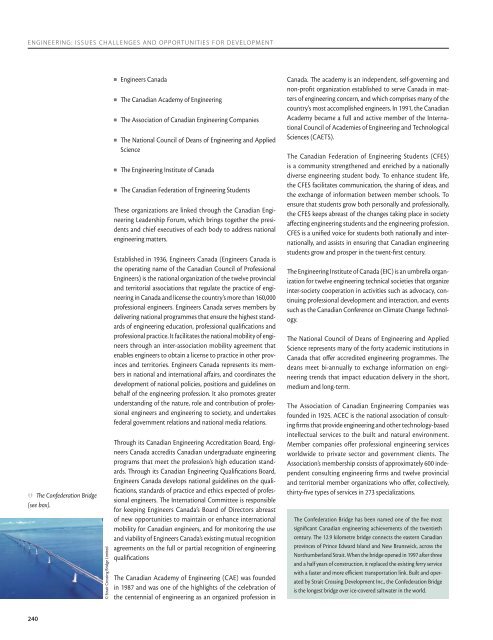Engineering: issues, challenges and opportunities for development ...
Engineering: issues, challenges and opportunities for development ...
Engineering: issues, challenges and opportunities for development ...
You also want an ePaper? Increase the reach of your titles
YUMPU automatically turns print PDFs into web optimized ePapers that Google loves.
ENGINEERING: ISSUES CHALLENGES AND OPPORTUNITIES FOR DEVELOPMENT The Confederation Bridge(see box).© Strait Crossing Bridge Limited■■■■■■Engineers CanadaThe Canadian Academy of <strong>Engineering</strong>The Association of Canadian <strong>Engineering</strong> CompaniesThe National Council of Deans of <strong>Engineering</strong> <strong>and</strong> AppliedScienceThe <strong>Engineering</strong> Institute of CanadaThe Canadian Federation of <strong>Engineering</strong> StudentsThese organizations are linked through the Canadian <strong>Engineering</strong>Leadership Forum, which brings together the presidents<strong>and</strong> chief executives of each body to address nationalengineering matters.Established in 1936, Engineers Canada (Engineers Canada isthe operating name of the Canadian Council of ProfessionalEngineers) is the national organization of the twelve provincial<strong>and</strong> territorial associations that regulate the practice of engineeringin Canada <strong>and</strong> license the country’s more than 160,000professional engineers. Engineers Canada serves members bydelivering national programmes that ensure the highest st<strong>and</strong>ardsof engineering education, professional qualifications <strong>and</strong>professional practice. It facilitates the national mobility of engineersthrough an inter-association mobility agreement thatenables engineers to obtain a license to practice in other provinces<strong>and</strong> territories. Engineers Canada represents its membersin national <strong>and</strong> international affairs, <strong>and</strong> coordinates the<strong>development</strong> of national policies, positions <strong>and</strong> guidelines onbehalf of the engineering profession. It also promotes greaterunderst<strong>and</strong>ing of the nature, role <strong>and</strong> contribution of professionalengineers <strong>and</strong> engineering to society, <strong>and</strong> undertakesfederal government relations <strong>and</strong> national media relations.Through its Canadian <strong>Engineering</strong> Accreditation Board, EngineersCanada accredits Canadian undergraduate engineeringprograms that meet the profession’s high education st<strong>and</strong>ards.Through its Canadian <strong>Engineering</strong> Qualifications Board,Engineers Canada develops national guidelines on the qualifications,st<strong>and</strong>ards of practice <strong>and</strong> ethics expected of professionalengineers. The International Committee is responsible<strong>for</strong> keeping Engineers Canada’s Board of Directors abreastof new <strong>opportunities</strong> to maintain or enhance internationalmobility <strong>for</strong> Canadian engineers, <strong>and</strong> <strong>for</strong> monitoring the use<strong>and</strong> viability of Engineers Canada’s existing mutual recognitionagreements on the full or partial recognition of engineeringqualificationsThe Canadian Academy of <strong>Engineering</strong> (CAE) was foundedin 1987 <strong>and</strong> was one of the highlights of the celebration ofthe centennial of engineering as an organized profession inCanada. The academy is an independent, self-governing <strong>and</strong>non-profit organization established to serve Canada in mattersof engineering concern, <strong>and</strong> which comprises many of thecountry’s most accomplished engineers. In 1991, the CanadianAcademy became a full <strong>and</strong> active member of the InternationalCouncil of Academies of <strong>Engineering</strong> <strong>and</strong> TechnologicalSciences ( CAETS).The Canadian Federation of <strong>Engineering</strong> Students (CFES)is a community strengthened <strong>and</strong> enriched by a nationallydiverse engineering student body. To enhance student life,the CFES facilitates communication, the sharing of ideas, <strong>and</strong>the exchange of in<strong>for</strong>mation between member schools. Toensure that students grow both personally <strong>and</strong> professionally,the CFES keeps abreast of the changes taking place in societyaffecting engineering students <strong>and</strong> the engineering profession.CFES is a unified voice <strong>for</strong> students both nationally <strong>and</strong> internationally,<strong>and</strong> assists in ensuring that Canadian engineeringstudents grow <strong>and</strong> prosper in the twent-first century.The <strong>Engineering</strong> Institute of Canada (EIC) is an umbrella organization<strong>for</strong> twelve engineering technical societies that organizeinter- society cooperation in activities such as advocacy, continuingprofessional <strong>development</strong> <strong>and</strong> interaction, <strong>and</strong> eventssuch as the Canadian Conference on Climate Change Technology.The National Council of Deans of <strong>Engineering</strong> <strong>and</strong> AppliedScience represents many of the <strong>for</strong>ty academic institutions inCanada that offer accredited engineering programmes. Thedeans meet bi-annually to exchange in<strong>for</strong>mation on engineeringtrends that impact education delivery in the short,medium <strong>and</strong> long-term.The Association of Canadian <strong>Engineering</strong> Companies wasfounded in 1925. ACEC is the national association of consultingfirms that provide engineering <strong>and</strong> other technology-basedintellectual services to the built <strong>and</strong> natural environment.Member companies offer professional engineering servicesworldwide to private sector <strong>and</strong> government clients. TheAssociation’s membership consists of approximately 600 independentconsulting engineering firms <strong>and</strong> twelve provincial<strong>and</strong> territorial member organizations who offer, collectively,thirty-five types of services in 273 specializations.The Confederation Bridge has been named one of the five mostsignificant Canadian engineering achievements of the twentiethcentury. The 12.9 kilometre bridge connects the eastern Canadianprovinces of Prince Edward Isl<strong>and</strong> <strong>and</strong> New Brunswick, across theNorthumberl<strong>and</strong> Strait. When the bridge opened in 1997 after three<strong>and</strong> a half years of construction, it replaced the existing ferry servicewith a faster <strong>and</strong> more efficient transportation link. Built <strong>and</strong> operatedby Strait Crossing Development Inc., the Confederation Bridgeis the longest bridge over ice-covered saltwater in the world.240

















